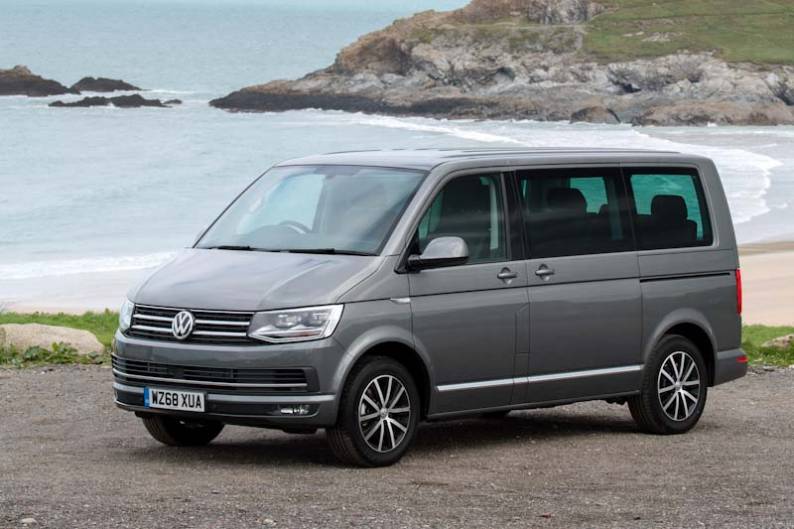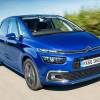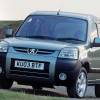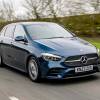
RAC sale – up to 33% off*
• Roadside cover from £5.29 a month†
• We get to most breakdowns in 60 mins or less
• Our patrols fix 4/5 breakdowns on the spot

By Jonathan Crouch
Introduction
Serious about space? So is Volkswagen's Caravelle. In contrast to the largest conventional MPVs on the market, it'll not only take seven people but all their luggage too, thanks to commercial origins refined by decades of development that have created a quality car-like feel for driver and passengers alike. This sixth generation T6 version sold between 2016 and 2021 was smarter, safer, more efficient and better connected. Ultimately though, the reason you'd buy one never changed. Namely that there isn't much from this period that can do what a Caravelle can.
Models
(5dr MPV 2.0 TDI 150PS, 204PS / 2.0 TSI [SE, Executive, Business])
History
The Volkswagen Caravelle. It was in its time in almost every way, the definitive extra-large people carrier. At its launch in 2016, this T6-era Caravelle was the latest instalment in over half a century of history that had seen this vehicle and its predecessors share and change the lives of countless families in almost every country of the world.
Such a simple concept you'd think - a windowed van for people rather than packages - but then the best ideas always are. This one came from a Dutch vehicle importer called Ben Pon who just after WW2, spotted workers at Volkswagen's Wolfsburg factory using a stripped-down Beetle to move parts around. Inspired, he sketched out a platform for a versatile commercial vehicle that would brilliant for business and, with seats and windows, fine for families too.
Following the 1950 launch, it was the seated versions that most captured the public's imagination, early versions of which were known by a whole variety of names - the Samba bus, the Kombi, the Microbus or even, in the swinging Sixties, the 'hippie bus'. In America, it was simpler: a people carrying Transporter was just known as a 'Volkswagen Bus'. These vehicles offered simple, utilitarian people transport but by the time the third generation T3 Transporter model was introduced in 1980, Volkswagen thought it had identified an extra market amongst buyers who liked the size and versatility but wanted to move their passengers around in more car-like surroundings. So was born the Caravelle.
The version launched in 2016 was based on the sixth generation T6 Transporter series that had been introduced back in mid-2015 and was of course a far cry from the crude but characterful original buses. It was one of three people-orientated Transporter derivations that Volkswagen was offering in this period, the other two being the California camper van and the more utilitarian nine-seater Shuttle minibus. The Caravelle was primarily based around a seven-seat configuration and needed the T6 package of updates to keep pace with the fresh standards being set by key van-based rivals in the super-large People Carrying segment, most notably the Mercedes V-Class. Hence a range of more powerful and efficient Euro6 engines, extra electronic safety equipment and a substantial upgrade in media connectivity. Plus, as before, there was the unique-in-class option of 4MOTION 4WD. The result, in this guise, could be just about anything buyers wanted it to be - a huge go-almost-anywhere family runabout, an up-market taxi or even a business limousine. This T6 generation Caravelle range sold until late-2021 when it was replaced by the replacement Multivan model.
What You Get
There's something a little more up-market about a Caravelle, a class and quality that marks it out from mainstream brand rivals. Visual updates to this T6 generation model included restyled headlights with optional LED illumination. But of course, what matters is found inside. What you get is three-person rear bench right at the very back that was re-designed for the T6 generation; and two single chairs in the middle that will usually be swivelled around to face it so that passengers can talk directly to each other rather than to the back of peoples' heads. From new, the front seats could optionally be turned to face those at the rear too and all models have a natty multi-function table that clips in and out of the floor and sits between second and third rows.
Whether the plan is for an impromptu business meeting on the M1 or it's just about keeping the kids quiet on the way to your weekend holiday cottage, these are features that really do make a huge difference to the way this car can be used, versatility further aided by the four floor-mounted rails. These enable the various rear seats to slide into just about any position you want, depending on the vehicle application you have in mind and the amount of people carrying or packaging space you're likely to need.
You'll have a bit more flexibility when it comes to doing that if you opt for the long wheelbase body style. This variant, only available to 2WD diesel customers, adds 20mm more roof height and another 400mm to the length.
And luggage space? Well this is where a super-large People Carrier like this comes into its own. With a conventional car-like large MPV, if all seven seats are occupied, it's unlikely that you'll also have enough space for everyone's luggage. With a Caravelle, it's different. Once you've negotiated the lifting of the huge rear tailgate (something you'll need to have left plenty of space behind the vehicle in order to be able to raise), the cargo capacity with all the seats in use is about double that amount that you'd get in a similar scenario with a large MPV, say like a Volkswagen Sharan.
And at the wheel? Well, you certainly sit high up - to the point where there's a feeling of sitting on top of the car rather than in it. For sure though, it's a commanding perch. The main interior change made to this T6 generation model related to infotainment connectivity. All models got a 5-inch 'Composition Colour' touchscreen that controls an eight-speaker DAB+ audio system.
What You Pay
Please fill in the form here for an exact up-to-date information.
What to Look For
The Caravelle often tops lists for being one of the most reliable large MPVs out there, so you're mainly looking at condition and service history in seeking the best one out. For every Caravelle that's spent the last few years coping with arduous family duties, there'll be another that's been cherished by someone who never troubled the maximum load capacity. Check the interior for marks and dents, along with the rest of the bodywork outside. If there's damage everywhere with burns or rips on the seats, then it's time to look elsewhere. Post-2015 models should have all service stamps in place from either a VW main dealer or at least a specialist. If any are missing, you'll have to wonder why.
The ownership survey we undertook revealed a mainly very satisfied set of owners, but a few issues were reported. Check that any necessary recalls have been carried out. There was one for a minor side airbag malfunction and another for models produced between July 2019 and February 2020 due to reported issues with the driver's door bowden cable malfunctioning in cold temperatures. Plus a recall was issued for a small number of T6 models due to three fuel hoses requiring replacement as they weren't manufactured to the needed specification. If you have the vehicle registration number of the Caravelle T6 you're looking at, it's possible to check the .gov database to see if all recalls have been carried out.
Check the car you're looking at out for poor starting and running: the well documented yellow EGR dashboard engine management light if illuminated could signal a serious issue that can affect T6 models of any mileage or age. Engine failures with Caravelles are very rare, but those that have occurred seem mainly to have been due to a malfunctioning EGR valve, which allowed coolant to escape into the engine cylinders. Beyond that, check the MOT history for signs of wear and tear. Make sure that no services had been missed as running the vehicle on old oil can damage its engine quite badly. We came across a few reports of leaks from the factory fitted side windows, so check those too.
Replacement Parts
(approx based on a 2018 Caravelle 2.0 TDI 150PS) A set of front brake pads are between £26-£55 but you could pay as much as £112 for a pricier brand. Rear pads are in the £20-£40 bracket. Front brake discs cost around £46 to £70 - or £60-£120 for rear discs. Brake callipers are around £125-£131 - it's around £143 for rear callipers. Air filters are in the £6 to £9 bracket. Oil filters cost around £5-£7 and fuel filters cost around £25. You'll pay around £6 to £15 for a wiper blade. A starter motor would be around £290 - with a pricier brand up to £525. Bash one of the wing mirrors and you're looking at paying around £120 if you need to replace the whole wing mirror unit. A water pump would be around £103 and an LED tail lamp will sit in the £197 to £200 bracket.
On the Road
You'll want to know whether it drives like a car-like MPV or a van-like minibus, so let's get that out of the way right up-front. The on-road experience is somewhere between the two, though your reaction might be more positive than that if you're not up to speed with just how dynamically adept the latest generation of large vans really are. In the short wheelbase version, parking and urban manoeuvring is easier than you might expect it to be in a vehicle this large thanks to the commanding driving position and glassy cabin. The lengthier long wheelbase body style might be more challenging though. You won't have the option of choosing that larger variant if you decide you want a 4WD Caravelle, one with the improved 4MOTION 4WD system that in this T6 model, offered up even more ways to use this very versatile vehicle.
Under the bonnet, though this T6 generation Caravelle was launched with a 2.0 TSI petrol option, almost all buyers will continue to choose their cars with a 2.0 TDI diesel and as ever with this model range, there's a choice of either single or twin turbo installations. For this T6 design, both units were upgraded: the base variant put out 150PS, while at the top of the range, the BiTDI powerplant developed 204PS. We think the 2.0 TDI 150PS derivative will be quite sufficient for the needs of most buyers, particularly as it was made more efficient for the T6 generation: in a manual model, you'll manage 45.6mpg on the combined cycle and 161g/km of CO2 (both NEDC figures) - and you can do even better than that if you opt a car with the 7-speed DSG auto gearbox.
Overall
So how ultimately, ought we to define the Volkswagen Caravelle? You might have started off seeing it as some kind of LCV, a perfectly reasonable assumption given that it's based on a Volkswagen Transporter panel van and when new was sold through Volkswagen Van Centres. But it's got seven seats, so you could also think it to be some kind of minibus. Until you clamber inside and discover that those chairs slide, fold and rotate - just like an MPV. But it's also more than that too, its arm-chair style seats and superior trim materials making it quite upmarket for the kids and more, perhaps, like an executive limousine. But let's stop this. What we know for sure is that the Caravelle, especially in this 2016-2021-era 'T6'-generation form, continues to be as versatile and difficult to pin down as ever.
And in summary? Well you will of course need to be part of a very big family or a very mobile business in order to fully justify Caravelle ownership. But if you can, then the conquest of space can start very comfortably at the wheel of one of these.







